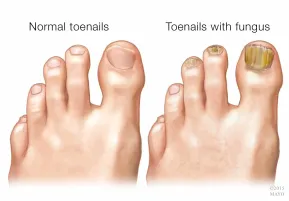
Toenail Fungus Treatment in Abingdon and Bel Air, MD
Symptoms
Fungal nail infections, also known as “onychomycosis,” are very common.
Most fungal nail infections are not serious. However, some people may experience pain or be bothered by the appearance of their nails.
Fungal nail infections may cause nails to become discolored, thick, fragile, or cracked. The nail may also become separated from the nail bed.
How does someone get a fungal nail infection?
Fungal nail infections are caused by many different types of fungi that live in the environment. Small cracks in your nail or the surrounding skin can allow these germs to enter your nail and cause an infection.
Who gets fungal nail infections?
Anyone can get a fungal nail infection. Some people may be more likely than others to get a fungal nail infection, including older adults and people who have the following conditions:
- A nail injury or foot deformity
- Trauma
- Diabetes
- Weakened immune system (for example, because of cancer)
- Venous insufficiency (poor circulation in the legs) or peripheral arterial disease (narrowed arteries reduce blood flow to the arms or legs)
- Fungal skin infections on other parts of the body
Occasionally, a bacterial infection can occur on top of a fungal nail infection and cause serious illness. This is more common in people with diabetes or other conditions that weaken the body’s defenses against infection.
Prevention
- Keep your feet clean and dry.
- Keep toenails short and clean.
- Don’t walk barefoot in areas like locker rooms or public showers.
- Don’t share nail clippers with other people.
- When visiting a nail salon, choose a salon that is clean and licensed by your state’s cosmetology board. Make sure the salon sterilizes its instruments (nail clippers, scissors, etc.) after each use, or bring your own.
Treatment
Fungal nail infections can be difficult to cure, and treatment is most successful when started early. Fungal nail infections typically don’t go away on their own, and the best treatment is usually prescription antifungal pills taken by mouth. In severe cases, a healthcare professional might remove the nail completely. It can take several months to a year for the infection to go away.
Fungal nail infections can be closely associated with fungal skin infections. If a fungal infection is not treated, it can spread from one place to the other. Patients should discuss all skin concerns with their healthcare provider to ensure that all fungal infections are properly treated.
Even after treatment, fungal nail infections can come back. This is more common in people who have conditions like diabetes that make them more likely to get a fungal nail infection. If you suspect an infection has returned, contact your healthcare provider.
